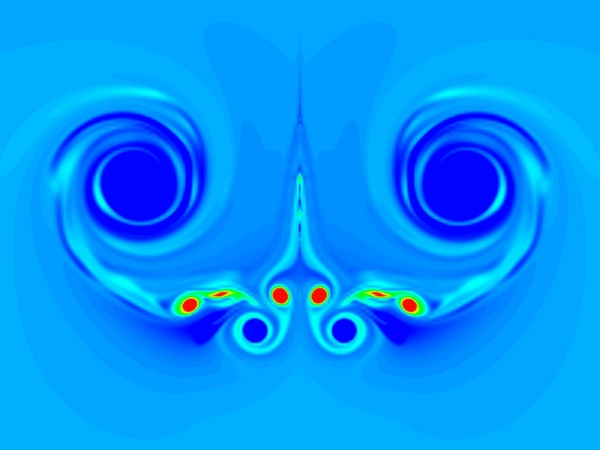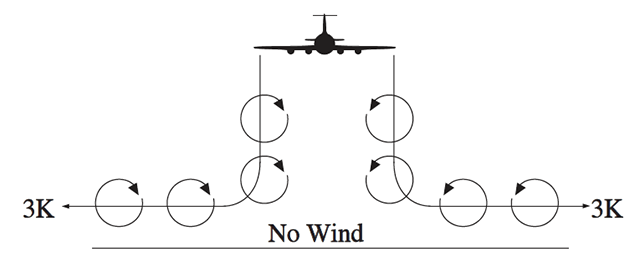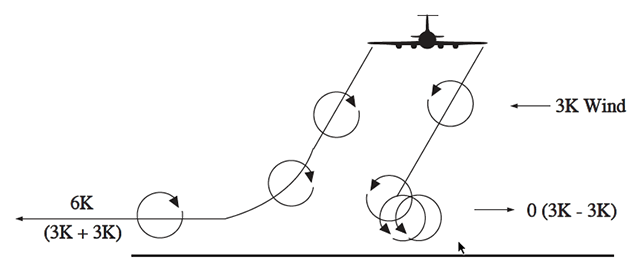Wing tip vortices? Well I've been on both sides of this problem. I was once fully inverted in a T-37, just 200 hundred feet off the deck, having been caught behind the wake of a much heavier FB-111. I became a believer. Years later I was flying a Boeing 747 where it was of no concern to me, other than as a matter of politeness to other, smaller, aircraft.
— James Albright

Updated:
2018-05-08
Now, flying Gulfstreams, I think about it a lot.
2 — Vortex avoidance procedures

1
The issue
Every aircraft generates a wake while in flight. Initially, when pilots encountered this wake in flight, the disturbance was attributed to “prop wash.” It is known, however, that this disturbance is caused by a pair of counter−rotating vortices trailing from the wing tips. The vortices from larger aircraft pose problems to encountering aircraft. For instance, the wake of these aircraft can impose rolling moments exceeding the roll-control authority of the encountering aircraft. Further, turbulence generated within the vortices can damage aircraft components and equipment if encountered at close range. The pilot must learn to envision the location of the vortex wake generated by larger (transport category) aircraft and adjust the flight path accordingly.
Source: Aeronautical Information Manual ¶7−3−1.a.
Vortex Generation
Lift is generated by the creation of a pressure differential over the wing surface. The lowest pressure occurs over the upper wing surface and the highest pressure under the wing. This pressure differential triggers the roll up of the airflow aft of the wing resulting in swirling air masses trailing downstream of the wing tips. After the roll up is completed, the wake consists of two counter−rotating cylindrical vortices. Most of the energy is within a few feet of the center of each vortex, but pilots should avoid a region within about 100 feet of the vortex core.
Source: Aeronautical Information Manual ¶7−3−2
Vortex Strength
The strength of the vortex is governed by the weight, speed, and shape of the wing of the generating aircraft. The vortex characteristics of any given aircraft can also be changed by extension of flaps or other wing configuring devices as well as by change in speed. However, as the basic factor is weight, the vortex strength increases proportionately. Peak vortex tangential speeds exceeding 300 feet per second have been recorded. The greatest vortex strength occurs when the generating aircraft is HEAVY, CLEAN, and SLOW.
Source: Aeronautical Information Manual ¶7-3-3.a.
Induced Roll
In rare instances a wake encounter could cause inflight structural damage of catastrophic proportions. However, the usual hazard is associated with induced rolling moments which can exceed the roll-control authority of the encountering aircraft. In flight experiments, aircraft have been intentionally flown directly up trailing vortex cores of larger aircraft. It was shown that the capability of an aircraft to counteract the roll imposed by the wake vortex primarily depends on the wingspan and counter control responsiveness of the encountering aircraft.
Source: Aeronautical Information Manual ¶7-3-3.b.1.
Vortex Behavior
Trailing vortices have certain behavioral characteristics which can help a pilot visualize the wake location and thereby take avoidance precautions.
- Vortices are generated from the moment aircraft leave the ground, since trailing vortices are a by-product of wing lift. Prior to takeoff or touchdown pilots should note the rotation or touchdown point of the preceding aircraft.
- The vortex circulation is outward, upward and around the wing tips when viewed from either ahead or behind the aircraft. Tests with large aircraft have shown that the vortices remain spaced a bit less than a wingspan apart, drifting with the wind, at altitudes greater than a wingspan from the ground. In view of this, if persistent vortex turbulence is encountered, a slight change of altitude and lateral position (preferably upwind) will provide a flight path clear of the turbulence.
- Flight tests have shown that the vortices from larger (transport category) aircraft sink at a rate of several hundred feet per minute, slowing their descent and diminishing in strength with time and distance behind the generating aircraft. Atmospheric turbulence hastens breakup. Pilots should fly at or above the preceding aircraft’s flight path, altering course as necessary to avoid the area behind and below the generating aircraft. However, vertical separation of 1,000 feet may be considered safe.
- When the vortices of larger aircraft sink close to the ground (within 100 to 200 feet), they tend to move laterally over the ground at a speed of 2 or 3 knots.
- A crosswind will decrease the lateral movement of the upwind vortex and increase the movement of the downwind vortex. Thus a light wind with a cross runway component of 1 to 5 knots could result in the upwind vortex remaining in the touchdown zone for a period of time and hasten the drift of the downwind vortex toward another runway. Similarly, a tailwind condition can move the vortices of the preceding aircraft forward into the touchdown zone. THE LIGHT QUARTERING TAILWIND REQUIRES MAXIMUM CAUTION. Pilots should be alert to large aircraft upwind from their approach and takeoff flight paths.
Source: Aeronautical Information Manual ¶7-3-4.a.
2
Vortex avoidance procedures
- Landing behind a larger aircraft- same runway. Stay at or above the larger aircraft's final approach flight path-note its touchdown point-land beyond it.
- Landing behind a larger aircraft- when parallel runway is closer than 2,500 feet. Consider possible drift to your runway. Stay at or above the larger aircraft's final approach flight path- note its touchdown point.
- Landing behind a larger aircraft- crossing runway. Cross above the larger aircraft's flight path.
- Landing behind a departing larger aircraft- same runway. Note the larger aircraft's rotation point- land well prior to rotation point.
- Landing behind a departing larger aircraft- crossing runway. Note the larger aircraft's rotation point- if past the intersection- continue the approach- land prior to the intersection. If larger aircraft rotates prior to the intersection, avoid flight below the larger aircraft's flight path. Abandon the approach unless a landing is ensured well before reaching the intersection.
- Departing behind a larger aircraft. Note the larger aircraft's rotation point and rotate prior to the larger aircraft's rotation point. Continue climbing above the larger aircraft's climb path until turning clear of the larger aircraft's wake. Avoid subsequent headings which will cross below and behind a larger aircraft. Be alert for any critical takeoff situation which could lead to a vortex encounter.
- Intersection takeoffs- same runway. Be alert to adjacent larger aircraft operations, particularly upwind of your runway. If intersection takeoff clearance is received, avoid subsequent heading which will cross below a larger aircraft's path.
- Departing or landing after a larger aircraft executing a low approach, missed approach, or touch-and-go landing. Because vortices settle and move laterally near the ground, the vortex hazard may exist along the runway and in your flight path after a larger aircraft has executed a low approach, missed approach, or a touch-and-go landing, particular in light quartering wind conditions. You should ensure that an interval of at least 2 minutes has elapsed before your takeoff or landing.
- En route VFR (thousand-foot altitude plus 500 feet). Avoid flight below and behind a large aircraft's path. If a larger aircraft is observed above on the same track (meeting or overtaking) adjust your position laterally, preferably upwind.
Source: Aeronautical Information Manual ¶7-3-6.b
3
Air traffic wake turbulence separation (US)
Because of the possible effects of wake turbulence, controllers are required to apply no less than specified minimum separation for aircraft operating behind a heavy jet and, in certain instances, behind large non heavy aircraft (i.e., B757 aircraft).
- Separation is applied to aircraft operating directly behind a heavy/B757 jet at the same altitude or less than 1,000 feet below:
- Heavy jet behind heavy jet - 4 miles.
- Large/heavy behind B757 - 4 miles.
- Small behind B757 - 5 miles.
- Small/large aircraft behind heavy jet - 5 miles.
- Also, separation, measured at the time the preceding aircraft is over the landing threshold, is provided to small aircraft:
- Small aircraft landing behind heavy jet - 6 miles.
- Small aircraft landing behind B757 - 5 miles.
- Small aircraft landing behind large aircraft- 4 miles.
- Additionally, appropriate time or distance intervals are provided to departing aircraft:
- Two minutes or the appropriate 4 or 5 mile radar separation when takeoff behind a heavy/B757 jet will be:
- From the same threshold.
- On a crossing runway and projected flight paths will cross.
- From the threshold of a parallel runway when staggered ahead of that of the adjacent runway by less than 500 feet and when the runways are separated by less than 2,500 feet.
- NOTE-Controllers may not reduce or waive these intervals.
Source: Aeronautical Information Manual ¶7-3-9.a.
A 3-minute interval will be provided for all aircraft taking off when the operations are as described in subparagraph b1 and 2 above, the preceding aircraft is a heavy/B757 jet, and the operations are on either the same runway or parallel runways separated by less than 2,500 feet. Controllers may not reduce or waive this interval.
Source: Aeronautical Information Manual ¶7-3-9.c.
Pilots may request additional separation i.e., 2 minutes instead of 4 or 5 miles for wake turbulence avoidance. This request should be made as soon as practical on ground control and at least before taxiing onto the runway.
Source: Aeronautical Information Manual ¶7-3-9.d.
4
Air traffic wake turbulence separation (EU)
The EU instituted a six category system which keeps the filing codes the same but adds subcategories with tailored separation minima. For more about this, see the European Wake Turbulence Categorisation and Separation Minima on Approach and Departure, known as RECAT-EU.
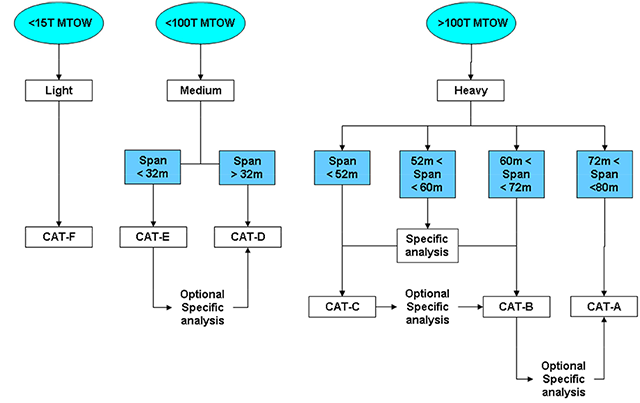
RECAT-EU Categories, from RECAT-EU, Figure 6.
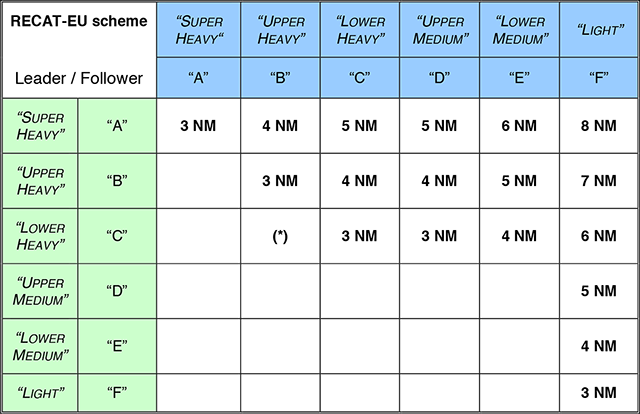
RECAT-EU Distance-based separation on approach and departure, from RECAT-EU, Table 3.
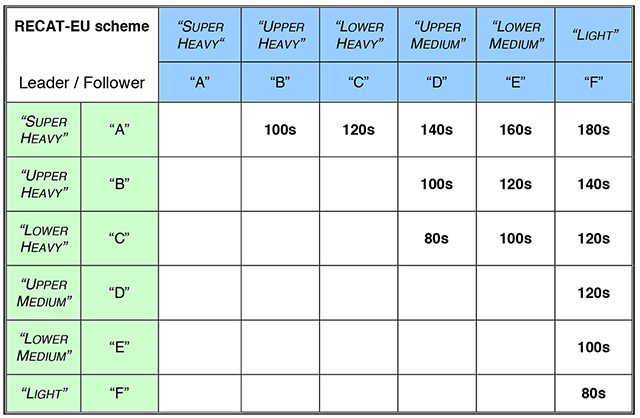
RECAT-EU WT time-based separation minima on departure, from RECAT-EU, Table 4.
References
(Source material)
Aeronautical Information Manual
RECAT-EU, European Wake Turbulence Categorisation and Separation Minima on Approach and Departure, Edition 1.1, 15/07/2015
